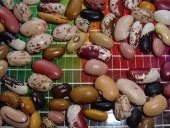
 3
3








bee well





 9
9












Joseph Lofthouse wrote:The conventional wisdom regarding beans, is that they only need to be planted far enough apart to avoid mechanical mixing. Say around ten feet. I recommend more than that.
Depending on ecosystem, beans cross pollinate at a rate of 0.5% to 5%. More humid climates with lots of carpenter bees may have cross pollination rates as high as 20%.
If green beans cross with dry beans, the pods become fibrous, so they are not nice for fresh eating, and the pods become hard to thresh. They are still good for eating as dry beans, just more work to clean the seeds.
One of my selection criteria for dry beans is easy threshing, so if green beans ever got mixed in with then, the trait would be self-eliminating because I only save seeds from easy threshing varieties.
Likewise, if I were maintaining a green-bean landrace next to a dry bean landrace, I would pick them by snapping the seed pod. If a pod didn't snap easily, I'd cull the plant right then.
If green beans cross with green beans, no worries, they will retain the non-fibrous pod.
My dry bush beans have around 70 phenotypes that I can identify with my eyes. I intend to plant all phenotypes every year.
If the dry beans and the bush beans are grown on opposite edges of the garden, they will mostly stay isolated.
I like to grow and ferment and frolic about and play.
 4
4




sam mintgreen wrote:
After having read so many conflicting opinions on a search for Phaseolus cross pollination distance, I'm quite glad to find this Lofthouse opinion. Hoping to grow a landrace and at least one heirloom variety of dry bean, if not multiple and maintain the heirloom(s), in land I may have an opportunity to begin stewarding/market gardening in. I am in a very humid region that will likely have LOTS of bees, so a good distance will be made between any cultivars I want to keep isolated. I am curious if large numbers of other flowers between the plants would reduce the distance needed or not? (lets say a good number of coriander and dill flowers for example? or even other genus of legume in between.)
Nothing ruins a neighborhood like paved roads and water lines.






